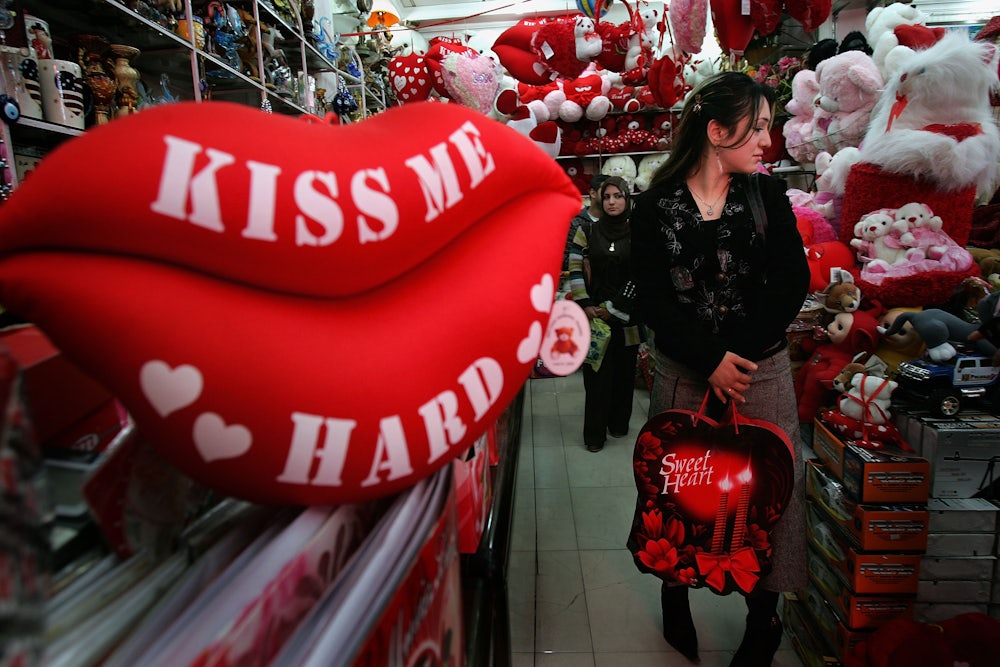Back in the early 1990s, Baptist pastor Gary Chapman released a book about human relationships. In its first year, the book barely made a splash, but the following year sales doubled. The year after that, they doubled again. By 2009, The Five Love Languages had reached the New York Times bestseller list, where it occasionally reappears to this day.
The book’s premise is that people feel loved and seen when their partner responds to them in their “love language” of quality time, physical touch, words of affirmation, acts of service, or receiving gifts. The concept clearly struck a chord, entering the secular cultural lexicon with remarkable speed. But relationship experts and researchers say that despite the $27 billion Americans spent on Valentine’s Day gifts last year, the language of gifts is often misunderstood—at huge cost both to individuals and the environment.
Gifts can serve as physical symbols of love and traditionally play an important part in celebrating life milestones. They come wrapped in social pressures and expectations, as well as paper: Showing up at a child’s birthday party or a wedding reception without an offering in hand can be a faux pas that strains a friendship.
Within romantic relationships, gifts are also often proffered as expressions of love. “The tradition of gift-giving goes far back in history as a way to communicate that we care about our relationships more than words can say,” explained Dr. Cindy Chan, an assistant professor of marketing at the University of Toronto, who published a study a few years ago on experiential and material gifts.
And retailers have learned to make the most of it. As Valentine’s Day approaches, shelves are stocked with giant teddy bears, boxes of chocolate, and other consumerist signifiers of affection. From drugstores to home furnishing stores and even the post office, displays make it clear that February 14 is the time to give—whether stuffed animals and candy are likely to appeal to your partner or not.
In fact, when it comes to love, most people don’t speak the gift language. According to an online survey conducted by Chapman (hardly scientific, of course—but then, little about the “love languages” is scientific), receiving gifts is the least common love language, with only 18 percent of participants claiming it as their own. Loving gestures are great. But making them with unnecessary and unwanted gifts—on Valentine’s Day or any other occasion—probably isn’t worth the toll it takes both on wallets and the planet.
That heart-shaped box of chocolates your loved one may or may not eat likely contains confections made with palm oil, which, when harvested unsustainably, drives deforestation and loss of wildlife habitat in Southeast Asia. Cacao farming has likewise proven remarkably resistant to eco-certification schemes. That’s not to mention the resources that go into producing the boxes and their stuffed-bear escorts.
The 145 million Valentine’s cards that are sold in the United States every year are often made from materials that can’t be recycled. A dozen red roses can also be a thorny choice, considering the emissions needed to transport them and keep them refrigerated. The jewelry you buy may be derived through an extractive process of mining for metals and gemstones that pollutes water, causes soil erosion, and has been the source of human rights injustices. Even romantic evenings out often revolve around menus with a hefty carbon footprint like steak dinners.
Sure—it’s a laundry list we might apply to any number of our purchasing practices. But the difference here is that over 40 million recipients don’t even want the gifts they’ll be given this Valentine’s Day, and those chocolates and teddy bears will likely end up in landfills.
So if we don’t want cookie-cutter gifts in the first place, why do so many of us feel compelled to go out and buy them? Why is the drive to buy considered evidence of affection?
Fifty-three percent of women in a survey published earlier this month said they would dump a partner who didn’t get them a Valentine’s Day gift. That may feel a little harsh, but the resentment caused by skipped gifts isn’t necessarily about greed; experts say exchanging gifts strengthens the connection between people on a deeper level. “There are cultural norms around gift-giving that we rely on,” Chan told me. “We give gifts to signal closeness. There are underlying emotions to receiving gifts, and emotions are so fundamental to relationships.” Those norms, though, have shifted dramatically over time.
Valentine’s Day once involved practical gifts—think gloves, for example—helping the besotted test the waters of their potential spouse’s ability to support them. The commercialization of Valentine’s Day, according to research by University of Nevada history professor Elizabeth Nelson, began in the late 1800s, when printing and paper production became more affordable. Hallmark was founded in 1911, and soon afterward, children began exchanging valentines at school.
Today, the advertising industry works hard to ensure Valentine’s Day gift-giving is a deeply ingrained cultural norm. Grocery store displays begin popping up before December is even over. Marketing slogans won’t let us forget that “a diamond is forever,” and even fast-food restaurants are selling heart-shaped sweets. This year, Dunkin’ Donuts is offering customers a chance to win a wedding at its drive-thru. The ubiquitous marketing campaigns might explain why we feel burned if our loved one doesn’t shower us with gifts on Valentine’s Day.
Ironically, while we may buy things for Valentine’s Day to celebrate a happy relationship, conspicuous consumption is correlated with loneliness—though it’s not yet understood whether this attachment to stuff is brought on by loneliness or causes it.
With all its cultural and consumerist ties, gift-giving isn’t going anywhere—but we can easily give in ways that are more personal and less wasteful. The first step, experts say, is to put real thought into your gift. “If you’re kind of lighthearted about [gift-giving] and just say, ‘Oh, well … I’ll just give them anything,’ but it’s not something they have an interest in, then it will not mean as much to them as if they realize, ‘Oh, you knew me well enough to know that I collect spoons’ or whatever it might be,” Chapman told HuffPost in a 2020 interview. “A thoughtful gift speaks more deeply than a gift given rather flippantly.”
But we can also rethink what gift-giving looks like in the first place. “People are happier after purchasing experiences rather than material goods,” Chan told me, and research shows that the recipients of experiential gifts are happier, too. Often experience gifts are associated with extravagant travel, or people assume they require too much planning. But that need not be the case. Cooking or baking someone’s favorite recipe, for example, is an act of service that has tangible results. Quality time can be given as an experiential gift, like planning an afternoon at your favorite park or a visit to your local museum. Experiential gift-giving has even been shown to improve relationships. And there are benefits for the environment, too. The pound of polyester required to make a teddy bear, for instance, causes twice the emissions of driving to the local wildlife sanctuary or preserve for a day date.
Both gift-givers and recipients derive more happiness from experiences, yet people still purchase more material gifts than experiential gifts. There’s research to suggest that how well we know someone can determine how likely we are to shift away from giving material goods. Experiential gifts are seen as more unique, Chan said, so there’s a sense of increased pressure in making the right choice.
Some people shy away from giving experiential gifts, she added, because they feel it’s riskier to give an experience that may be perceived as an obligation, requiring time. She recommends alleviating this worry by building in flexibility, for instance by purchasing a gift card so the recipient can plan the experience at their leisure or letting them know that you’d like to give them the activity and allowing them to pick the date and time.
Expressions of love are almost always culturally determined, but as our society continues to be confronted by the specter of environmental crisis, there’s never been a better time to start making new traditions. And you might even improve your love life by rejecting modern Valentine’s Day’s planet-killing norms. “A relationship is a collection of shared experiences,” Chan said. Those rarely arrive in a heart-shaped box.








